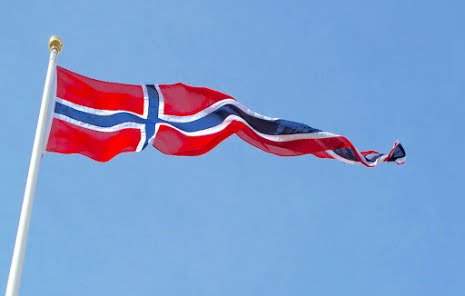
Origins of the Vimpel
The vimpel, also known as a pennon or a small flag, has a rich and intriguing history that dates back centuries. This distinctive triangular-shaped flag has been used by various cultures and civilisations as a symbol of identity, pride, and belonging.
In Nordic and Scandinavian tradition, this 'household pennant' is fairly common (Finnish: isännänviiri; Swedish: vimpel; Norwegian: vimpel; Danish: vimpel) and can be flown whenever there is no flag flying day. It usually means that the "master of the house" is at home.
These vimpel pennants have a long, narrow, triangular shape, usually half the length of the flagpole and are also used in some countries for determining the wind direction. Unlike the national flag, which usually has a specific timeframe it can formally be flown during the day, pennants are regarded as more informal, and can be flown all day and night until worn out.
Danish pennants retain the cross of the Dannebrog and are generally very long and thin. The pennants can be connected to the pole like a traditional flag, or via a single lanyard, giving the pennant the ability to rotate while flying.
Finnish pennants retain the cross design of their national flag. The pennants triangle has a base of roughly one tenth of the length and it is connected to the pole via a single lanyard, giving the pennant the ability to rotate while flying.The shapes, designs and uses of the pennants are however not regulated by law, as long as they do not interfere with uses of the regular flag, which is regulated. It is also allowed to fly a pennant overnight.In addition to the general pennant (which is based on the flag of Finland) and the regional variants, there are also family, city and municipality variants, of which any may be flown. A common practice is to either fly the pennant of the region of residence or the pennant from which the family members come.
The different regions of Finland have been connected with some traditional colors (often from the coats of arms of the historical provinces of Finland and modern provinces), and these are often reflected in the household pennant. The pennants sometimes also incorporate the regional arm into the design. A common practice is to either fly the pennant of the region of residence or the pennant from which the family members come. As the household pennant is connected to the pole with a single lanyard, the pennant has the ability to revolve around its horizontal axis. Thus, an actual pennant does not have a "top" side, making some of the pennants identical in practice.
![]() Pennant of Central Finland
Pennant of Central Finland
![]() Pennant of Central Ostrobothnia
Pennant of Central Ostrobothnia
![]() Pennant of Kainuu
Pennant of Kainuu
![]() Pennant of Kymenlaakso
Pennant of Kymenlaakso
![]() Pennant of Lapland
Pennant of Lapland
![]() Pennant of Northern Ostrobothnia
Pennant of Northern Ostrobothnia
![]() Pennant of Satakunta
Pennant of Satakunta
![]() Pennant of Savonia
Pennant of Savonia
![]() Pennant of Southern Ostrobothnia
Pennant of Southern Ostrobothnia
![]() Pennant of Southwest Finland
Pennant of Southwest Finland
![]() Pennant of Swedish-speaking Ostrobothnia
Pennant of Swedish-speaking Ostrobothnia
![]() Pennant of Tavastia
Pennant of Tavastia
![]() Pennant of Uusimaa
Pennant of Uusimaa
![]() Pennant of Swedish-speaking Uusimaa/Nyland
Pennant of Swedish-speaking Uusimaa/Nyland
The colors of the coat of arms
![]() Pennant of Kymenlaakso
Pennant of Kymenlaakso
![]() Pennant of Pirkanmaa
Pennant of Pirkanmaa
![]() Pennant of North Karelia
Pennant of North Karelia
![]() Pennant of Päijät-Häme (1983-1997)
Pennant of Päijät-Häme (1983-1997)
Norwegian pennants do not contain the nordic cross and instead uses a single stripe in blue with white borders on a red triangular canvas. Although they may sometimes appear different such as with the nordic cross motif of the national flag, but these alternative designs are very uncommon compared to the single stripe design. Municipal specific pennants are also sometimes used by certain national subdivisions as decorations. When pennants of other Nordic countries are flown in Norway alongside the Norwegian pennant, the design of the single stripe is carried over to the other Nordic pennants.
The design of Swedish pennants, unlike other Nordic pennants, are regulated. These pennants must be half blue and half yellow, with blue on top. Swedish pennants with cross designs are not approved, considered historically inaccurate and is therefore advised to not be used. The length of the pennant should be 1/3 of the flagpole. The colors are not defined, but should match those of the national flag.
![]() Sweden (with cross)
Sweden (with cross)
![]() Scania
Scania
 Sami Pennant
Sami Pennant
Ancient origins
The origins of the vimpel can be traced back to ancient times. In ancient Egypt, vimpels were used to denote military ranks and were carried into battle as a symbol of honor and bravery. Similarly, ancient Roman legions used vimpels to identify different cohorts and to boost morale on the battlefield.
Medieval heraldry
During the medieval period, vimpels became an integral part of heraldry. Nobles and knights would display their coats of arms on vimpels, which were often affixed to lances or carried by attendants during tournaments and processions. These vimpels served as a visual representation of their lineage, achievements, and affiliations.
Maritime usage
The vimpel also found its place on the high seas. Sailors would attach vimpels to the mastheads of their ships to identify their vessel from a distance. These flags not only aided in navigation but also acted as a form of communication between ships, allowing sailors to relay messages or warnings.
Modern significance
In modern times, vimpels are still used in various contexts. In sports, vimpels are often displayed by fans to show support for their favorite teams. They can be seen waving proudly in stadiums and arenas, creating a vibrant and energetic atmosphere.
In some cultures, vimpels are used as decorative and ceremonial items. They are displayed during festivals, weddings, and other important occasions, adding a touch of tradition and festivity to the festivities







